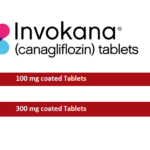Invokana side effects are similar to other SGLT-2 inhibitors including Jardiance, Farxiga, and Steglatro. As a class, the most common side effect of Invokana is urinary tract and genital yeast infection.
Canagliflozin (Invokana) is an FDA-approved medication to treat type 2 diabetes, lower the risk of CVD, and treat newly developed kidney disease.
This medication offers good glycemic control with significant weight loss when used in combination with a balanced diet and daily physical activity.
The “2023 ADA standards of care guidelines” recommend all patients with heart failure and clinical ASCVD (atherosclerotic cardiovascular disease) to receive any of the three SGLT-2 inhibitors:
Despite being highly effective, Canagliflozin is associated with side effects that may limit its use.
Go Organic | Try Dibesity’s Premium Catalogue
Invokana Side effects:
Invokana side effects are discussed. However, these side effects are considered a class effect rather than associated with Invokana alone.
The risk of amputation and association with fractures are associated more with Invokana compared with other SGLT-2 Inhibitors.
1. Dehydration and Polyuria:
Canagliflozin works by eliminating excess body sugars through urine, which leads to polyuria (excessive urination) that might cause dehydration, resulting in fatigue, lightheadedness, and dizziness.
There is an increased risk of developing dehydration if you:
- Are taking any diuretics
- Have a low blood pressure
- Are on a low-sodium diet
- Have kidney issues.
Your risk of dehydration increases if you urinate more frequently than usual. That’s why it’s critical to stay hydrated while taking this medication.
Consider limiting your fluid intake a few hours before bedtime to help reduce night-time disturbance.
How to avoid dehydration when using Invokana?
Before Invokana treatment is initiated, the volume status of the patient should be assessed. If a person is on water pills (diuretics), that may need dose reduction or sometimes discontinuation.
Fluid intake should be enough to avoid dehydration. Excessive exertion should be avoided. Patients should take a water bottle with them if going out for a strenuous activity.
In case the blood pressure falls or the person develops blackouts and dizziness, hospitalization may be necessary for intravenous fluid administration.
2. Genital yeast infections
The most commonly observed side effect of Canagliflozin is genital infections in both men and women. However, these are slightly more common among women.
Yeast infections such as candidiasis and vulvovaginitis can occur which might cause
- Itching
- Yellowish discharge
- Burning and discomfort
According to reports, Canagliflozin administration in women caused 10.6 and 11.6% of yeast infections with dosages of 100 and 300 mg respectively.
To avoid yeast infection, wear light underwear with a cotton crotch and avoid wearing tight-fitting clothes to reduce your chances of getting a yeast infection.
Switch to pads instead of tampons and change out of sweaty workout clothes or wet swimsuits as soon as possible.
Other common conditions, such as bacterial vaginosis, can exhibit symptoms similar to yeast infections.
However, because these conditions are not treated in the same way, it is critical to consult your doctor immediately if you have any symptoms of a genital infection.
Canagliflozin can occasionally cause a serious bacterial infection in the genital area known as Fournier’s gangrene.
Consult your provider if you have pain and swelling in the genital and anal areas, associated with an abnormal odor, or a persistent fever.
Symptoms of male penile yeast infection (In men penile yeast infections such as balanitis or balanoposthitis cause:
- Redness
- Swelling
- Rashes or sores
- Foul-smelling discharge
- Painful urination
3. Ketoacidosis
Canagliflozin can also lead to life-threatening conditions such as diabetic ketoacidosis. This is more commonly observed among people who are on extremely restrictive diets or drink excessive alcohol.
Patients taking Canagliflozin who have metabolic acidosis should be carefully monitored for ketoacidosis and the drug administration should be stopped immediately if any sign of ketoacidosis exists.
Ketoacidosis can develop in all patients who are on an SGLT-2 inhibitor. However, patients who are insulin deficient are more likely to develop DKA.
It is important to note that DKA can occur with Canagliflozin and other SGLT-2 Inhibitors despite normal blood glucose. This is termed “euglycemic ketoacidosis”
All patients on Invokana (Canagliflozin) should think of DKA if they develop vomiting, abdominal pain, and difficulty in breathing regardless of the blood glucose levels.
Patients may need to check their blood ketones and should not delay visiting ER.
4. Hyperkalemia
Hyperkalemia or high levels of potassium in the blood is also another side effect associated with the use of canagliflozin.
Hyperkalemia is more common among patients who have renal impairment or take certain medications that interfere with the renin-angiotensin system.
Serum potassium levels should be regularly monitored in patients at high risk of hyperkalemia. And a low-potassium diet should be administered.
5. Lower limb amputation
Lower limb amputation was previously listed as a boxed warning on Invokana (the necessary removal of a toe, foot, or other parts of your leg).
A boxed warning is the most serious risk a medication can be assigned by the FDA. However, the FDA removed the warning in 2020 after new research revealed that the risk was lower than previously thought.
However, if you have a history of amputation, such as a diabetic foot ulcer, inform your doctor before beginning Invokana.
A previous amputation, problems with blood flow (peripheral vascular disease), and nerve problems are all risk factors (neuropathy).
Take care of your feet to reduce your risk of amputation. This includes checking the feet on a regular basis for any abnormal changes, such as foot sores.
Other Possible Side Effects:
Some other side effects that can also be caused by canagliflozin are:
- Hypoglycemia:
Hypoglycemia can especially occur if the medication is used in combination with other glucose-lowering drugs or with insulin.
- Bone fractures:
Canagliflozin has been linked to lower levels of estrogen which increases the risk of osteoporosis and weak bones that are prone to fractures.
- Increased LDL-C:
An increase in levels of LDL cholesterol has also been observed in patients taking canagliflozin.
- Kidney Impairments:
Abnormalities in kidney function can also occur with the use of canagliflozin because the medication lowers GFR and increases serum creatinine levels.
Drug Interactions
Drug interactions can prevent the drugs from performing their functions properly in the body. These can be prevented by dose adjustments.
Canagliflozin can have drug interactions with:
- Diuretics
- Digoxin
- Phenytoin (for seizures)
- Certain medications for treating tuberculosis such as rifampin
- Ritonavir for HIV
Who Should Avoid Canagliflozin?
People who have these conditions should avoid taking canagliflozin:
- Have previously had an allergic reaction to this medication
- Severe kidney damage
- Type 1 diabetes
- Ketoacidosis
- Liver disease
If you have experienced any of these conditions, tell your healthcare provider before starting your treatment.
Conclusion:
Canagliflozin is an effective treatment for type 2 diabetes. However, like all other medications, it also has some associated risks and side effects which must be considered before starting the treatment
Genital infections, dehydration, and amputations are among the most common side effects of canagliflozin.
Consult your doctor to select the best treatment according to your condition with the lowest chance of serious side effects.
Go Organic | Try Dibesity’s Premium Catalogue



